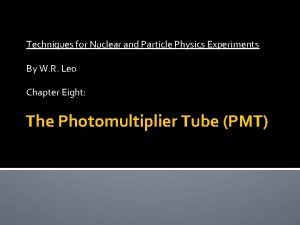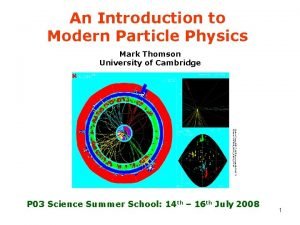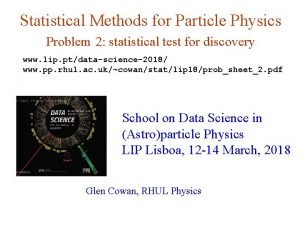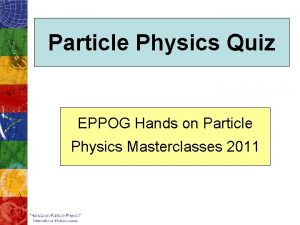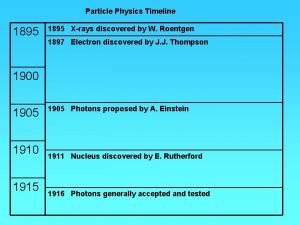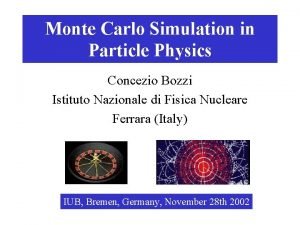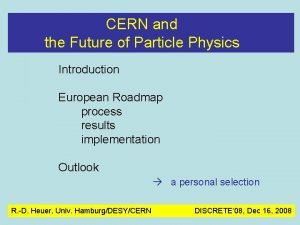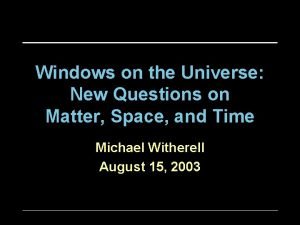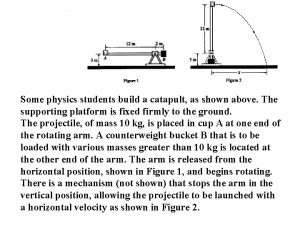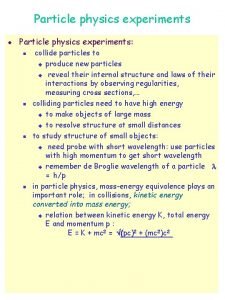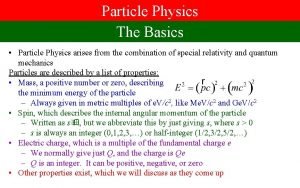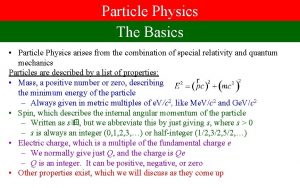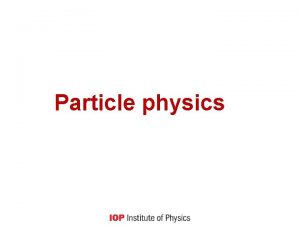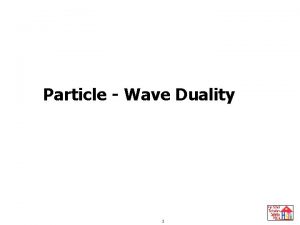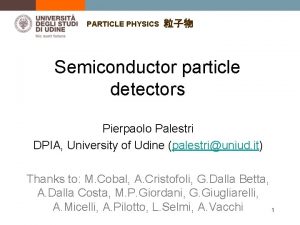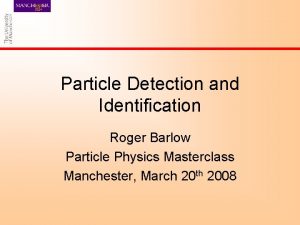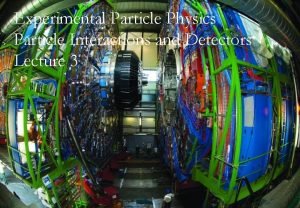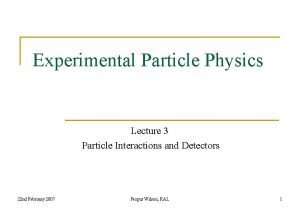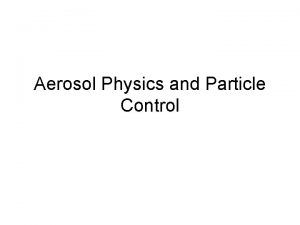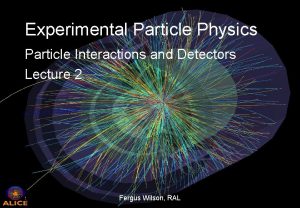Introduction to Particle Physics for non physics students


























































- Slides: 58

Introduction to Particle Physics (for non physics students) 3. FORCES


Gravity wins for large bodies and reveals surprises that may link with particles



What is dark matter? Electrically neutral. Hot DM – lightweight like neutrinos Cold DM – heavyweight Maybe SUSY (next lecture)

Colour and the Strong Force How quarks work: CHROMOSTATICS (like electrostatics but with three types of + (-) charges)

Three colour charges + Quarks “positive” _ Antiquarks “negative” + + _ _ Now use familiar rules “Like charges (colours) repel; opposite (colours) attract”

Simplest state: QQ* Meson + meson

The THREE colours enable quarks to attract one another making BARYONS (e. g. the proton)


Three colour charges neutralise Makes baryon (e. g. proton)

Simple nucleus (deuteron)

Electric charge Colour charge Atoms Molecules Baryons Nucleus

Quantum Electrodynamics: QED Electric charge Atoms Molecules Quantum Chromodynamics: QCD Colour charge Baryons Nucleus

Quantum Electrodynamics: QED Electric charge Atoms Molecules Interaction of electric charges and photons Quantum Chromodynamics: QCD Colour charge Baryons Nucleus Interaction of colour charges and gluons

Feynman diagrams for electromagnetic interaction e “strength” photon e x e/4 pi = 1/137 = “alpha” e ee ee

Feynman diagrams for chromomagnetic interaction g “strength” gluon g x g/4 pi ~1/10 = “alpha_s” g qq qq qq

Feynman diagrams for chromomagnetic interaction g “strength” gluon g x g/4 pi ~1/10 = “alpha_s” g qq qq qq

Feynman diagrams for electromagnetic interaction Quantum effects Virtual e+e- pairs… Resolved at high p “alpha” varies with p e “strength” photon e x e/4 pi = 1/137 = “alpha” grows with p ~ 1/128 at p ~ 100 Gev e ee (when p --> 0) ee

Feynman diagrams for chromomagnetic interaction Like QED, QCD has g “strength” gluon and also g x g/4 pi ~1/10 = “alpha_s” g “alpha_s” falls with p = is big at small “STRONG” force qq qq qq = small at large p p “p. QCD” in HEPhys

Quantum Electrodynamics: QED Electric charge Atoms Molecules Interaction of electric charges and photons “alpha” = 1/137 small; perturbation; 12 places of decimals Quantum Chromodynamics: QCD Colour charge Baryons Nucleus Interaction of colour charges and gluons

Quantum Electrodynamics: QED Electric charge Atoms Molecules Interaction of electric charges and photons “alpha” = 1/137 small; perturbation; 12 places of decimals Quantum Chromodynamics: QCD Colour charge Baryons Nucleus Interaction of colour charges and gluons short distance: high momentum “alpha” = 1/10 small; perturbation; “p. QCD” v. precise hadron size: low momentum “alpha” = large. lattice/models

Feynman diagrams for electromagnetic interaction

Feynman diagrams for electromagnetic interaction

Feynman diagrams for electromagnetic interaction

Photon Emag Gluon Strong W Weak Feynman diagram for QCD analogous QED: electron; positron; photon QCD: quark; antiquark; gluon Theory => Z; expt confirmed

The Electroweak Story Part 1: The WEAK Force

Fermi model (1934) of neutron beta decay Effective strength “G_F ” “Fermi constant” deduced by observed rate of beta decay. Empirical. No theory (1934) Small = feeble = “weak”

Fermi model (1934) of neutron beta decay Now look into the black box with a modern high resolution microscope and reveals W-boson being exchanged Effective strength “G_F ” “Fermi constant” deduced by observed rate of beta decay. Empirical. No theory (1934) Small = feeble = “weak”

Photon Emag Gluon Strong W Weak p Fermi model n Theory => Z; expt confirmed

Photon Emag Gluon Strong W Weak Theory => Z; expt confirmed

Photon Emag m= 0 Gluon Strong m= 0 W Weak m= 80 x proton Theory => Z; expt confirmed

Photon Emag m= 0 Gluon Strong m= 0 W Weak m= 80 x proton How can 1 eject 80? Quantum weirdness: Heisenberg uncertainty unlikely “weak” Theory => Z; expt confirmed

The Electroweak Story Part 2: History and Unity “Weak force as Electromagnetism in disguise”

The Electroweak Story




1996 -2000 -

The Electroweak Story Part 3: Unity “Weak force as Electromagnetism in disguise”

Beta decay (weak interaction): Feynman diagram for Fermi’s original model “weak strength” 1/100, 000 Ge. V^2 contrast with “emag strength” Notice a number (e. m. ) but dimensions of 1/Ge. V^2 (weak)……… e x e/4 pi = 1/137 = “alpha”

Feynman rules: If energy E flows through the transmitted “virtual” particle (photon; Z) it costs 1/(E^2+M^2)

Feynman rules: If energy E flows through the transmitted “virtual” particle (photon; Z) it costs 1/(E^2+M^2) If E >> M the cost is 1/E^2…. like the case of the photon

Feynman rules: If energy E flows through the transmitted “virtual” particle (photon; Z) it costs 1/(E^2+M^2) If E >> M the cost is 1/E^2…. like the case of the photon If E << M the cost is 1/M^2

Fermi model Feynman rules: If energy E flows through the transmitted “virtual” particle (photon; Z) it costs 1/(E^2+M^2) If E >> M the cost is 1/E^2…. like the case of the photon If E << M the cost is 1/M^2

“weak strength” 1/100, 000 Ge. V^2 = 1/137 x 1/(28 Ge. V)^2

“weak strength” 1/100, 000 Ge. V^2 = 1/137 x 1/(28 Ge. V)^2 “weak” has fundamentally electromagnetic strength if m ~ 30 Ge. V

“weak strength” 1/100, 000 Ge. V^2 = 1/137 x 1/(28 Ge. V)^2 “weak” has fundamentally electromagnetic strength if m ~ 30 Ge. V More carefully: root 2; parity violation; SU 2 x U 1; Weinberg angle. . requires m(W) ~ 80 Ge. V; m(Z) ~ 90 Ge. V Experimentally verified!!



WEAK STRONG

WEAK STRONG why sun has shone for 5 Byr… àIntelligent life developed

The weak force is feeble in the Sun…. . because 10, 000 K ~ 1 ke. V << 80 Ge. V …this is why the sun has stayed active long enough for us to have evolved and be having this conversation. àWe exist because m(W) is not zero Mass matters

A Very Short Introduction Coming out in December NEW More in Vsi And particle odyssey



QED (electrons and photons) QCD (quarks and gluons) LEP @ CERN 1989 -2000
 Non non non ne failliront jamais lyrics
Non non non ne failliront jamais lyrics How jose become the champion of filipino student?
How jose become the champion of filipino student? Pmt particle physics
Pmt particle physics Mark thomson particle physics
Mark thomson particle physics Particle physics
Particle physics Particle physics practice quiz
Particle physics practice quiz Particle physics timeline
Particle physics timeline Monte carlo simulation particle physics
Monte carlo simulation particle physics Cern particle physics
Cern particle physics European laboratory for particle physics
European laboratory for particle physics Cern particle physics
Cern particle physics Particle physics
Particle physics Form factor particle physics
Form factor particle physics International masterclasses hands on particle physics
International masterclasses hands on particle physics Non cellular particle
Non cellular particle Some physics students build a catapult
Some physics students build a catapult Non working students
Non working students Kontinuitetshantering
Kontinuitetshantering Novell typiska drag
Novell typiska drag Nationell inriktning för artificiell intelligens
Nationell inriktning för artificiell intelligens Returpilarna
Returpilarna Varför kallas perioden 1918-1939 för mellankrigstiden
Varför kallas perioden 1918-1939 för mellankrigstiden En lathund för arbete med kontinuitetshantering
En lathund för arbete med kontinuitetshantering Adressändring ideell förening
Adressändring ideell förening Tidbok yrkesförare
Tidbok yrkesförare A gastrica
A gastrica Densitet vatten
Densitet vatten Datorkunskap för nybörjare
Datorkunskap för nybörjare Boverket ka
Boverket ka Debattinlägg mall
Debattinlägg mall Delegerande ledarstil
Delegerande ledarstil Nyckelkompetenser för livslångt lärande
Nyckelkompetenser för livslångt lärande Påbyggnader för flakfordon
Påbyggnader för flakfordon Lufttryck formel
Lufttryck formel Publik sektor
Publik sektor Urban torhamn
Urban torhamn Presentera för publik crossboss
Presentera för publik crossboss Argument för teckenspråk som minoritetsspråk
Argument för teckenspråk som minoritetsspråk Kanaans land
Kanaans land Treserva lathund
Treserva lathund Mjälthilus
Mjälthilus Claes martinsson
Claes martinsson Centrum för kunskap och säkerhet
Centrum för kunskap och säkerhet Byggprocessen steg för steg
Byggprocessen steg för steg Mat för idrottare
Mat för idrottare Verktyg för automatisering av utbetalningar
Verktyg för automatisering av utbetalningar Rutin för avvikelsehantering
Rutin för avvikelsehantering Smärtskolan kunskap för livet
Smärtskolan kunskap för livet Ministerstyre för och nackdelar
Ministerstyre för och nackdelar Tack för att ni har lyssnat
Tack för att ni har lyssnat Vad är referatmarkeringar
Vad är referatmarkeringar Redogör för vad psykologi är
Redogör för vad psykologi är Matematisk modellering eksempel
Matematisk modellering eksempel Atmosfr
Atmosfr Borra hål för knoppar
Borra hål för knoppar Orubbliga rättigheter
Orubbliga rättigheter Formel för standardavvikelse
Formel för standardavvikelse Tack för att ni har lyssnat
Tack för att ni har lyssnat Steg för steg rita
Steg för steg rita


